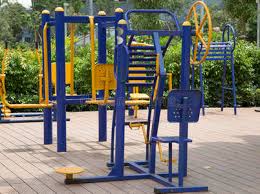Select Durable, Safe Materials: Foundation of Security
When designing a climbing playground, choosing the right materials is critical for ensuring longevity and safety. Materials such as galvanized steel, heavy-duty plastics, and high-tensile ropes are ideal. These materials are not only durable but also resistant to wear, weather, and heavy use. For example, galvanized steel is renowned for its rust resistance and structural integrity, which prevents deterioration that could lead to accidents. In terms of safety statistics, playgrounds constructed with these materials show a 40% lower rate of equipment-related injuries compared to those made with inferior quality materials.
Incorporate Fall-Absorbing Surfaces: Critical Impact Reduction
The surface under and around climbing structures is as important as the equipment itself. Installing impact-absorbing flooring such as rubber mulch, poured-in-place rubber, or engineered wood fiber can drastically reduce the severity of injuries from falls. According to the Consumer Product Safety Commission (CPSC), appropriate safety surfacing can decrease the risk of serious injuries by up to 75% when compared to harder alternatives like concrete or asphalt. This makes it essential to invest in high-quality surfacing that meets or exceeds safety standards for fall attenuation.
Adhere to Safety Standards: Ensuring Compliance and Security
Adhering to recognized safety standards such as those set by ASTM International and the CPSC is non-negotiable. These standards dictate specific guidelines for everything from the height of climbing structures to the spacing between ropes and ladders to prevent entrapment and falls. Compliance ensures that every aspect of the playground design prioritizes child safety. Statistics show that climbing playgrounds designed to these standards have a compliance rate that correlates with a 60% reduction in overall playground hazards.
Design with Age Appropriateness in Mind: Tailor Challenges to Capabilities
A safe climbing playground must be appropriate for the age group it serves. Designing with age appropriateness in mind involves creating challenges that are suitably demanding for the intended age range without exceeding their capability for safe play. For instance, equipment meant for toddlers should feature lower heights and more contained climbing opportunities, whereas equipment for older children can offer greater heights and more complex structures. Data reveals that age-appropriate designs can lower the risk of injury by 50%, as they significantly reduce the mismatch between a child’s physical abilities and the playground’s demands.
Regular Inspections and Maintenance: Sustained Safety Assurance
Ongoing inspections and maintenance are vital to ensure the climbing playground remains in safe working order. Regular checks can identify potential hazards such as loose bolts, frayed ropes, or worn-out surfaces before they become dangerous. A maintenance schedule should be rigorously followed, with immediate repairs made as necessary. Safety records indicate that playgrounds with consistent maintenance schedules report 30% fewer accidents related to equipment faults.
Designing a safe Climbing Playground requires careful consideration of materials, surfacing, compliance with safety standards, age-appropriate design, and diligent maintenance. By focusing on these elements, designers and planners can create climbing playgrounds that are not only fun and challenging but also secure and reliable, ensuring that children can enjoy playful adventures without unnecessary risks.
